North Perth is a suburb rich in History and heritage. There are 72 places registered on the Vincent Municipal Heritage Inventory in North Perth. Learn more below on ten of these places of state significance.
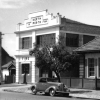 North Perth Fire Station
North Perth Fire Station
20 View Street, North Perth
The original North Perth Fire Station was located on the corner of Fitzgerald and Forrest Streets in North Perth from 1904-1926. It was staffed largely by part time volunteer firefighters.
After WWI, the fire service was professionalised, and the North Perth Fire Brigade moved to a new station on View Street in 1926.
The North Perth station was one of the first designed by architect and volunteer firefighter K.C. Duncan, who designed many of Perth’s suburban fire stations in the 1930s-1960s.
The fire station was operational until 1956, then became the first fire service training school in Western Australia. In 1963, it was sold by the Fire Brigades Board to North Perth baker Jury Tolcon and leased for commercial and residential use over the next decades. The building was State Heritage listed in 2004 and is currently owned by the United Professional Firefighters Union of Western Australia.
State Heritage Office: Heritage Listing Place
Suburban Bravery: The Fireman of North Perth 1902-1926, by Andrew Duckworth (2015) Available in the Local History Centre.
City of Vincent Image Library Photographs
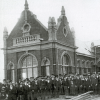 North Perth Town Hall
North Perth Town Hall
20-26 View Street, North Perth
The North Perth Lesser Hall was designed by Henry Procktor and constructed in 1902, following the formation of the Municipality of North Perth in 1901. The larger main hall, now called the Town Hall, was built later in 1910. Although not built to his original design, Prockter was involved in the planning of the larger adjoining Town Hall. In 1933, an addition to the front of the Town Hall brought it in line with the Lesser Hall. A verandah was added in 1978.
Both halls were used as municipal chambers and offices until 1914, when the Municipality of North Perth amalgamated with the City of Perth.
After 1914, the halls were used variously as overflow classrooms for the North Perth Primary School, or as venues for a number of societies and community groups, as well as for the Infant Health Centre, which was housed here until a separate building was added on the eastern side of the Lesser Hall. Currently both Halls are owned by the City of Vincent and used for civic, social and cultural activities.
The North Perth Town Hall complex was State Heritage listed in 1999.
State Heritage Office: Heritage Listing Place
City of Vincent Image Library Photographs
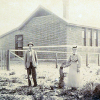 North Perth Primary School
North Perth Primary School
Albert Street, North Perth
In 1887, one and a half acres of the Toorak Estate was purchased for a school. Woodville School opened on 30 January 1899 with 131 students and 3 staff. The school was named North Perth State School by 1904.
By 1921, the school was the largest in the State and its resources were stretched. The girls walked to Leederville School for domestic science classes and the boys walked to Highgate School for manual arts. The North Perth Lesser Hall was also used for overflow classes. In January 1922, the North Perth Infant School opened to cater for the large number of students.
Two blocks on Albert Street were set aside as an extra school site and, in 1943, this ground was levelled to create a playing field. This area was named Goonderup, a Noongar name that described the area around the Redemptorist Monastery and appeared on maps in the early 1900s.
The school was renovated in the 1970s, with a new administration area, library and staff room and refurbishment of all classrooms. Goonderup was enlarged, requiring the removal of some houses and Olive Street was closed to through traffic.
In 1990, as enrolment numbers declined, the Junior Primary School was incorporated into the main school and the Junior Primary (formerly Infants) building was modified to house the School of Instrumental Music, the Education Department’s headquarters for music teachers.
The school was State Heritage listed in 2005.
State Heritage Office: Heritage Listing Place
North Perth Primary website
City of Vincent Image Library Photographs
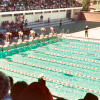 Beatty Park
Beatty Park
220 Vincent Street, North Perth
The Beatty Park Aquatic Centre was built in 1962 for the British Empire & Commonwealth Games. It was built on a former night-soil and rubbish dump turned reserve named after WWI British naval officer Sir David Beatty.
It comprises the first Olympic size swimming pool, diving pool, and spectator gallery built in Western Australia for international competition. It was upgraded in 1993-94 and again in 2012 and re-named Beatty Park Leisure Centre. Beatty Park has played a prominent role in the development of swimming in Western Australia.
State Heritage Office: Heritage Listing Place 03553
City of Vincent Image Library Photographs
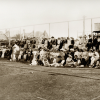 Woodville Reserve
Woodville Reserve
Namur Street, North Perth
Woodville Reserve was gazetted for recreational use by the North Perth Council in the early 1900s. The Reserve became a hub for sporting clubs and community gatherings, with the establishment of the North Perth Bowls Club in 1907; the North Perth Tennis Club in 1913 and the Woodville Cricket Club in 1928. Soccer was also played on Woodville Reserve from the 1920s onwards. During World War II searchlights, anti-aircraft guns and air raid shelters were positioned around the park’s edge. After the war, soccer, bowls and tennis continued to be played on Woodville Reserve.
In recent times, the space has been used by community groups such as Multicultural Services of WA, who ran a senior’s wellness centre from 2004 to 2019, the Vincent Men’s Shed (est. 2014) and the North Perth Community Garden (est. 2013).
City of Vincent Image Library Photographs
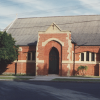 St Hilda's Anglican Church
St Hilda's Anglican Church
13 Glebe Street, North Perth
In the early 1900s, the first Anglican (then known as Church of England) Sunday School services in the parish, known as All Saints Woodville, were held at the home of Mrs Hahn, on the corner of Olive and View Streets. The first church services were held in the Gibson Hall, corner of Angove and Daphne Streets, and in the North Perth State School.
In 1904, a wooden building transported from Canning Mills was erected on the corner of Rose and View Streets, and consecrated as St Hilda’s North Perth. It was named after St Hilda of Whitby in Yorkshire, England. The foundation stone for the present church was laid on 24 July 1915 by William Loton MLA. The church was consecrated on 10 October the same year. Also in 1915, Rose Street was renamed Glebe Street, a ‘Glebe’ being an area of land within an ecclesiastical parish used to support a parish priest.
In 1954, St Hilda’s church was completed with the addition of the entrance porch, chancel, sanctuary, choir and priest vestries. The additions were consecrated on 12 December 1954 by Archbishop Robert Moline.
St Hilda’s boasts the oldest font in Australia. The stone font, which is used for baptisms, dates from the 9th or 10th Century and is of English origin. It was transferred to the church when St John’s Church in Milligan Street was demolished in 1928.
St Hilda’s was State Heritage listed in 1989.
State Heritage Office: Heritage Listing Place
City of Vincent Image Library Photographs
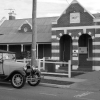 North Perth Police Station
North Perth Police Station
81 Angove Street, North Perth
The North Perth Police Station was designed by Hillson Beasley in the Federation Free Classical style and built in 1908. It consisted of a single storey building with cells, an attached resident and veranda with distinct red brick and cement rendered bands (colloquially known as ‘blood and bandages’). The building housed North Perth’s first policeman, Constable James Strappe, who had been assigned to North Perth in 1903 and had been previously living and working out of rented buildings, prior to construction of the North Perth Police Station.
The premises were partially renovated in 1943 and further additions were made in the 1960s. By the 1990s, five police officers and a cadet were based at North Perth, but the two cells were used for storage space. By 2000, the Mirrabooka Police District Training Centre had taken over part of the quarters. The Tactical Investigation Group also moved in and the station ceased to function as a suburban police station.
The original building was heritage listed in 1999.
The Town of Vincent purchased the property in 2009 and subsequently sold it to the School of Early Learning who renovated the property and opened the North Perth School of Early Learning in 2018.
State Heritage Office: Heritage Listing Place
Old North Perth Police Station by Peter Conole
City of Vincent Image Library Photographs
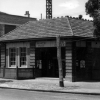 Old North Perth Post Office
Old North Perth Post Office
Corner Leake and View Streets, North Perth
Early postal services in North Perth consisted of agencies in local shops and a branch Post office was established on the corner of Alma and Fitzgerald Streets in 1912. Land for the North Perth Post Office was acquired on Leake and View Streets by the Postmaster General’s Department in 1905. However, it was not until 1916 that the North Perth Post Office and residence was constructed. It was designed by Hillson Beasley, in the style of previous post office architects George Temple Poole and JH Grainger.
As the population of North Perth grew, and Fitzgerald Street developed as a main shopping hub, patronage at the Post Office declined and a new building was constructed on the corner of View and Fitzgerald Streets.
The old North Perth Post Office became an Australia Post administrative centre for a number of years. In 2006, local fashion designer Aurelio Costarella opened his Post Emporium fashion business in the building. The building is currently occupied by Artists@Play Makeup Academy and the Prodigal Son Cafe.
The building was State Heritage listed in 1998.
State Heritage Office: Heritage Listing Place
City of Vincent Image Library Photographs
 Redemptorist Monastery and Church
Redemptorist Monastery and Church
190 Vincent Street, North Perth
The Redemptorist Monastery and Chapel was built for the Catholic Order of Redemptorists in 1903. Designed in the Federation Gothic style by Michael and James Cavanagh, the building comprises a three-storey limestone monastery and church complex, with a tiled roof and detailed decorative features. Further additions were completed in 1911/12 (Monastery East Wing additions), 1922 (the Chapel additions) and 1967 (adjacent Retreat House). The Redemptorist Monastery is a residence for the Brothers and is also used as an annual retreat for the clergy of the diocese and church services for the local community.
The heritage listed building symbolises the development of the Catholic Church in Western Australia, It has been the base for Redemptorist activities in pastoral care and missionary work in Western Australia from the arrival of the first Redemptorist Fathers in 1899 until the present day.
The building was State Heritage listed in 2006.
State Heritage Office: Heritage Listing Place
City of Vincent Image Library Photographs
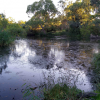 Charles Veryard Reserve and Smith’s Lake
Charles Veryard Reserve and Smith’s Lake
Albert Street, North Perth
Charles Veryard Reserve is located on a former wetland known to the local Noongar people as Danjanberup. European colonists named the area ‘Three Island Lake’ and later ‘Smith’s Lake’, after local farmer John Smith. Gradually, the lake diminished as the area was drained and developed for farming and market gardening.
From 1914-1937, the City of Perth acquired much of the former lake areas for redevelopment as parks and recreation areas. The lake itself was used as a rubbish tip, where old military equipment was reportedly dumped after WWII. Chinese market gardener John Gooey's land was resumed by the Perth City Council in 1959, and the area was levelled and subdivided for housing. A recreation reserve was created and named after Charles Veryard, who served on the Perth City Council from 1927-1967. The oval became the home of the North Perth Cricket Club and Old Modernians Hockey Club.
All that remains of the former wetland is the Smith’s Lake compensating basin on Bourke & Kayle Streets, rehabilitated in 1997 by the Claisebrook Catchment Brook.
City of Vincent: Heritage List